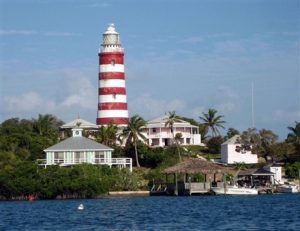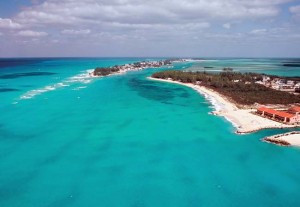March 24, 2011
By Jeff Weakley
Eye on the Islands
It's time to start making preparations for your Bahamas fishing vacation.

Palm fronds clattered like bones in the unsettled westerly. Our boat shifted on its moorings. The sky was starless black. We'd just escaped the worst summer squall of our lives, and it felt good to be standing on the dock, sipping a cold drink and listening to tarpon bust bait at the edge of the lights.
Jeff Allen was a childhood best friend I hadn't seen in decades, and here he was. Out of the blue he'd contacted me via e-mail, said he would be in town for his wife's business trip. "What do you know about fishing in South Florida?" he'd asked. Contemporary friends of mine know that line of questioning can be dangerous, leading to improvised epic quests at random compass points. This one commenced about 50 miles east of Miami, on the storied island of Bimini, fishing gateway to The Bahamas.
I'd hoped to ratchet up the excitement level for a man who once passed as my twin brother, but tonight was over the top: Deep-jigging for mutton snapper in the late afternoon, 10 miles from a keyhole Bahamas reef cut, in the impetuous weather of early September. While we raced to get back to the harbor, the sun set prematurely behind an ominous wall. If not for the courage of the fearless crew (namely, David Trafton and his brother Steve) well, who knows.
Safe and sound, we finished our drinks and strung up a couple of spinning rods to attend to those tarpon. I'd brought some sabiki rigs in my gear bag, and we affixed one to a rod to jiggle up small goggle-eyes for bait. We'd then transfer bait to the other rod for deployment.
The tarpon wised up to our ploy after a few explosive, gill-clattering cartwheels, but a school of 10-pound horse-eye jacks moved in to keep the action fast and furious. A horse-eye is a dignified cousin of the crevalle, content to lie low in daylight, reserving energy for nocturnal forays on the reefs and in harbors throughout the islands.
It was grownup excitement, but in its simplicity not far removed from the carp and bluegill fishing my pal and I enjoyed in the muddy runs which coursed our old neighborhood.
Jeff and I hooked four tarpon and a half dozen or more horse-eye jacks that night, and the next morning dawned clear and calm for a fun day of bluewater trolling and more jigging off Great Isaac. He got his first taste of grilled dolphin and skipjack in the dining room of the Bimini Big Game Club.
April heralds the start of prime time for Bahamas travel, and every year, as I get to planning my own excursions (hopefully, Cat Island this summer), I think back on things I've learned from past trips. I've had the good fortune to have traveled to the islands on an array of conveyances: private boats big and small, as well as aircraft of varying configurations. I've been to first-rate fishing resorts, as well as holes-in-the-wall.
On these adventures, I've seldom found myself in anything resembling real danger, except for that September night off Bimini-and that was largely due to our own indiscretion. One sure rule for navigating these islands is that the best place to watch the sun set is at the hotel bar. We were lucky that we had a return route to steer by on our chartplotter-but as many veteran cruisers will tell you, electronic gadgetry is no substitute for a daylight view of these reef-studded waters.
Make that Lesson One for mariners.
For the most part, Bahamas travel-whether aboard your own boat or by air-is relaxing and rewarding. It's close to South Florida, with seasonally better fishing and a greater likelihood of running into someone who speaks English. What more could you want?
This month we've assembled a resource guide, complete with current regulations, pertinent contact information, and thumbnail portraits of select popular destinations, indexed to past magazine coverage.
General Information on the Islands
The government-sponsored Bahamas Ministry of Tourism does an admirable job of informing boaters about destinations and travel regulations through its Web site, www.bahamas.com. You can also obtain general information live at 1-800-32-SPORT.
The Bahama Out Islands Promotion Board (www.bahama-out-islands.com; 954-475-8315) specializes in the outlying cays, and represents some intimate hotels and fishing hotspots.
There are also some good publications out there, including the venerable-and routinely updated-Yachtsman's Guide to The Bahamas. This helpful source for mariners is available at lots of boating shops, or on-line at www.yachtsman guide.com.
For a look at the history, people and customs of these unique islands, a good read I picked up at my local bookstore this winter is the Discovery Channel Insight Guide to the Bahamas. Another interesting book, if you like natural history, is The Ephemeral Islands: A Natural History of The Bahamas, by David Campbell.
The Bimini Isles

This is the closest point for boaters arriving from Miami-Dade or Broward counties, at just over 40 nautical miles. For that reason it's hugely popular-and at times (like holiday weekends) extremely busy. Spring and early summer are great times to hook a blue marlin along the Gulf Stream, or a monster kingfish on the Bank. Yellowtail and mutton snapper fishing can also be spectacular over the reefs. There are limited bonefish flats here, but local guides are knowledgeable and the fish run pretty large.
Not much in the way of beaches, shopping or other resort-type activities on these little islands. Some good scuba diving and snorkeling, but by and large the Biminis are frequented by fishermen. Cruising anglers capitalize on the short run from Florida, but fly-in anglers may find it worthwhile to enjoy a few days of flats fishing and perhaps an offshore charter. The Chalks' seaplane service out of Miami is a thrill in itself, complete with splash-landing alongside 50-foot sportfishing yachts in North Bimini Harbor. Refresh yourself and reprise the day's fishing at the Compleat Angler, End of the World or one of the other locally owned spots.
There are a half-dozen or more hotels catering to boaters, but it's best to make reservations well in advance. Bimini Big Game Club, now under new ownership (www.biminibiggame.com; 1-800-737-1007) is a good option-especially as it was recently renovated-but there are others.
You'll want optimal weather for crossing the Gulf Stream. April and May are a toss: Some years very windy, others calm. June through August are usually most dependable for light winds and clear skies, though afternoon storms are possible.
Last fall, frequent traveler Dave Kresge published the Bimini Cruising Guide. This seems to be a solid compendium of vital info for visitors. Check out biminicruisingguide.com, or call (954) 303-3153.
Last time we covered Bimini in detail was in April 2002.
Grand Bahama

This big island is the closest point for Palm Beach through St. Lucie County boaters. It's second only to Nassau/New Providence in terms of population, industry and development-but still a fine destination. Freeport is a bustling work town and the Lucaya district has something of a Disney-meets-Vegas atmosphere, but there are gems to explore, like the vast bonefish flats on the north side of the island, among the finest in the entire archipelago. The first Customs and Immigration offices you'll find here are at Old Bahama Bay Marina (www.oldbahamabay.com; 800-444-9469). The marina has fuel and other marine services, and there's an updated resort here. Port Lucaya Marina (www.portlucaya.com; 242-373-9090), farther east along the island, has a Customs and Immigration office to go with its ample dockage and comfortable, reasonably priced hotel rooms. The marina has fast become headquarters for a number of fishing tournaments, including the Ba
cardi Billfish Tournament, held there last month. Count Basie Square, with live music, restaurants and bars, is where it's at after dark. Reference April 2003 for a look at Lucaya.
Berry Isles

The Pocket, a northwestern arm of Tongue of the Ocean, sees one of the hottest blue marlin bites in the region in April and May. Chub Cay and the venerable Chub Cay Club (www.chubcay.com; 800-662-8551) is right at the doorstep, with marina services, food and lodging. Great Harbor Cay is another fine bluewater destination. May 2000 was the last time we visited Chub Cay.
Nassau/New Providence
Atlantis/Paradise Island Resort has one of the world's most spectacular marine aquariums, as well as a casino, restaurants, water slides and other activities. There are other fine resorts in the area. Fishing is limited mainly to a few big-boat charters who troll heavy tackle for wahoo, tunas and a smattering of reef fish. No flats fishing to speak of-though you can easily charter a plane to numerous outer islands.
Nassau (the name of the city is often used interchangeably, if incorrectly, with the island) is a wonderful place to spend a long weekend, but it's not much fun if you're six hours from a connecting flight to someplace else. My rule of thumb is, if I have to connect through Nassau, I'm staying at my target destination at least four days.
Nassau has long been on my list of Christmas vacations. I've always wanted to catch the colorful and raucous Junkanoo parade, for which virtually the entire city turns out. Junkanoo is celebrated on Boxing Day (a national holiday on Dec. 26) and again on New Year's Day. Costumed revelers shake down the streets to the beat of drums and bells in the Bahamas' answer to Mardi Gras or Carnival.
Eleuthera
Harbour Island-specifically Valentine's Resort and Marina (242-333-2142)-is a traditional outpost for intrepid Florida boaters. Yellowfin tuna and blue marlin fishing is world-class.
The main island of Eleuthera, extending south from Harbour Island for another 100 miles or so, is also an attractive spot for fly-in fishermen. There is a number of places to hole up and chase bonefish or sunshine for a few days, and the road system offers access to some pretty good flats. You'll get some idea of the fishery in the March 2001 issue.
Abacos

The Abacos comprise such an important and diverse fishing destination that we decided to devote an entire issue to it. Such famous fishing spots as Walkers Cay, Spanish Cay, Guana Cay, Treasure Cay and Elbow Cay are scattered along the northern reefline that fronts the Little Bahama Bank.
See next month's issue for a complete look at the cruising and angling opportunities here. And stay tuned for future coverage of fishing Bahama Out Islands.
FS
Florida Sportsman Classics
